Samsung Galaxy Tab - The AnandTech Review
by Vivek Gowri on December 23, 2010 9:48 AM ESTSamsung Galaxy Tab - Performance
The Galaxy Tab’s internal hardware feels pretty familiar. As with the Galaxy S phones and the newly launched Nexus S, there’s a Hummingbird chip underhood. Samsung’s proprietary SoC bundles a 1GHz Cortex A8 with Imagination’s PowerVR SGX540 GPU and 512MB of LPDDR1.
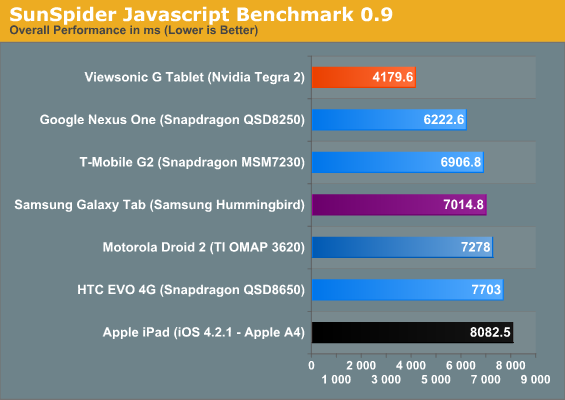
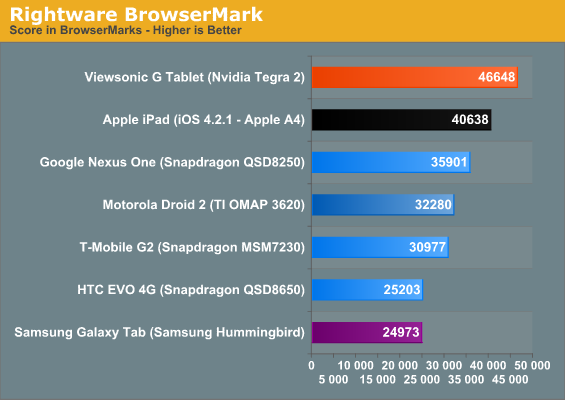
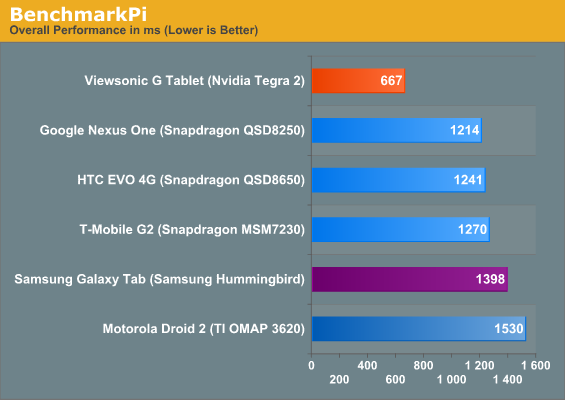
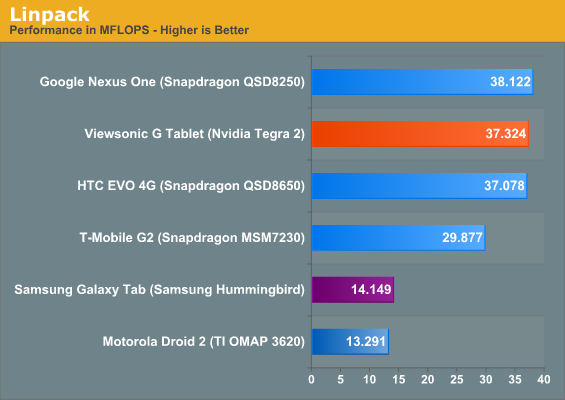
Performance is about expected, given how the Galaxy S devices performed. The second generation 45nm Snapdragon chips are really nipping at the heels of Hummingbird, even surpassing it on the CPU side in our benchmarks. Snapdragon has always had strong FPU performance so the Linpack score is expected, but in SunSpider’s JavaScript benchmark, we see the 1GHz myTouch 4G basically beat everything this side of the Cortex A9/Tegra 2 combo. We talked more about how A9 compared to A8 in our Tegra 2 performance preview here, so look at that to see how the Galaxy Tab stacks up against the tablet platform of the future.
On the graphics benchmark side, we only have two tablets to compare head to head - the Galaxy Tab and the Viewsonic G Tablet that we used in the Tegra 2 preview. The Galaxy Tab handily won out in Neocore - the 54 fps figure is basically capped by the vsync - but the Tegra 2 exhibited slightly faster performance throughout the rest of our smartphone graphics benchmarks. We initially had some issues with Quake 3 on the Tab, as detailed in our Tegra 2 performance update, but overall, SGX 540 is definitely competitive as far as graphics performance goes even if it isn't the clear cut leader anymore.

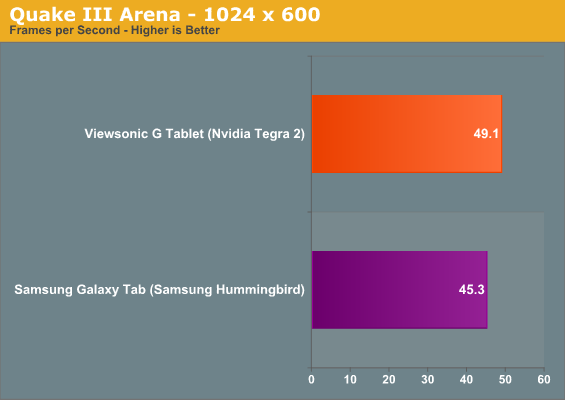
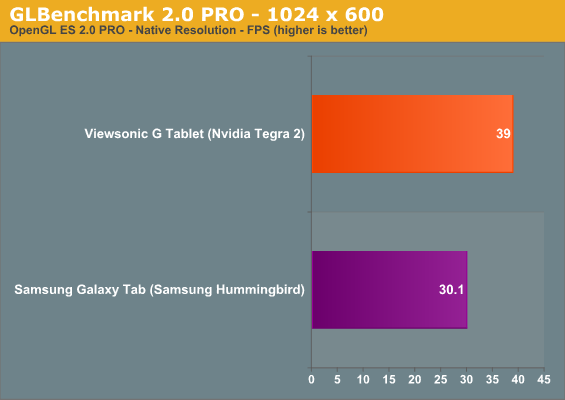

Our Galaxy Tab unit was a Verizon model, but for some reason the 3G data was very slow. I’ve tested it in multiple regions in the Seattle area and I have yet to break 700 kbps down and 500 kbps up. I haven’t had a Verizon device to test before, but even so, speeds around 600 kbps are not what I was expecting. I later talked to some Verizon employees and was told that such speeds are normal for Verizon 3G in Seattle, so their LTE rollout really can't happen fast enough.










97 Comments
View All Comments
trip1ex - Thursday, December 23, 2010 - link
because tablet software is made for the tablet while the software that is run on netbooks is developed for machines that are much more powerful with bigger screens and keyboards.
That's a big reason why netbooks are a crappy user experience and the experience on the iPad is a great user experience.
vld - Thursday, December 23, 2010 - link
How about the Archos 70 or 101 internet tablets? Direct comparison is definitely possible with the Froyo2.2 update from their web page.tipoo - Thursday, December 23, 2010 - link
Do they have those for testing? I'm defiantly interested in those, with Froyo and potentially Honeycomb plus jailbreaking those look like solid contenders for a much entry lower price.Rick83 - Thursday, December 23, 2010 - link
Got a 101 for my parents for christmas...it's certainly not in the same league as the iPad and G-Tab, but at the price it doesn't have to be. And at least you get hdmi out and a usb host (with an extra adapter on the 70).If Archos could spare 5p for some marketing, they'd be a major player.... Sadly, their finances are a bit strained....And they're French :-O
Also, I continuously fail to see why people pay laptop money for sub-netbook hardware, just because someone went and threw the keyboard away. It's pretty ridiculous....At their pricepoints the Archos tablets are sensible products - slightly more portable than a netbook, and direct interaction UIs (ie touchscreens), while priced in the same region. The expensive tabs don't do significantly more, but the extra cost is just astronomical. Even 50% more, so in the 450-500 euro/$ range would be expensive....
TareX - Thursday, December 23, 2010 - link
It was a nice attempt on Samsung's behalf, but I knew I would be waiting for the Honeycomb 8.9" Tegra 2 tablets instead, like the LG Optimus Pad...rs2 - Thursday, December 23, 2010 - link
"So what then? It’s the software. Or, to be more specific, Froyo. It’s too similar to a smartphone right now, too much of the same experience repeated on a 200% scale."...and the iPad is the same experience as the iPhone on a 400% scale. You can't place the Galaxy Tab second to the iPad just for having the same problem as the iPad.
robco - Thursday, December 23, 2010 - link
That would be true of the first version of the software. It was a bit of a kludge. Now we know that the iPad was actually conceived first, so you could say the iPhone is a scaled down iPad.But Apple did create a lot of new UI widgets specifically designed to take advantage of the larger screen real estate. Froyo doesn't have this. Apple released a new version of the SDK with an iPad emulator, Samsung had to put their own together without Google. I'm not holding out much hope for a good standard UI on Android either. Google is a great engineering company, but they miss out on the "soft" skills. Apple is good at both. I know Google has UI designers, but it doesn't appear that they listen to them very much. They seem to be more with Android over their other products, but that's not saying a whole lot. iOS looks clean and professional, Android does not.
I think in the end, people want a clean, polished product where the underlying technology isn't in your face, but is useful and makes it easy to get things done. MS is learning this lesson. Google needs to.
VivekGowri - Thursday, December 23, 2010 - link
@rs2 - if you read my software section, I said exactly that - having a scaled up OS never held the iPad back, so it's not something I can hold against the Galaxy Tab. What I can hold against the Galaxy Tab is that there are basically no apps, first party or otherwise, that take advantage of the larger screen size, other than the three or four apps that Samsung put in afterwards (Mail, Calendar, Contacts, etc). Apple basically changed every core app on the iPad to use that screen real estate, and they had more than a few high profile 3rd party apps out for the iPad - ABC player, NYT, BBC, etc etc. I don't doubt that Google will get there, probably with Honeycomb, but until then, it's a legitimate problem.Rick83 - Friday, December 24, 2010 - link
Actually, there are both screen size and resolution variables that apps can read and adopt to, which only recently have been expanded to cover up to 10" (in 2.3) and 7" (in 2.2).So the issue with the apps is just a matter of time.
Also, tablets are much like TVs: consumption devices. You set the channel/insert your media and lean back. (Unless you belong to the group of idiots that mistake the devices for portable gaming systems...) In this scenarion UI scaling isn't as important as it may seem. Actually, even on my 5" 800x480 tablet, individual features are very small, and I prefer the easier reading on the big screen of the Samsung.
Voldenuit - Thursday, December 23, 2010 - link
>I’m not much of a Swype guyHeretic!!!~ :P